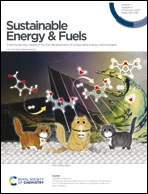Disclosing the superior lithium storage of double-shelled Si@N-doped carbon: a synergic combination of experiment and theory†
Abstract
Through collective use of experimental investigation and theoretical approaches, i.e., X-ray diffraction (XRD), X-ray photoelectron spectroscopy (XPS), Raman spectroscopy, microscopic properties and density functional theory (DFT) calculations, we comprehensively characterize the structural, morphological, and lithium (Li) storage performance of double-shelled silicon@ZIF-8@ZIF-67 (Si@DNC). The unique architectures not only absorb the huge volume variation stress of Si during cycling but also provide enhanced electrical conductivity and manipulate the stability and integrity of a well-wrapped double-shelled framework. Additionally, N-doped carbon can also enhance the conductivity of electrodes. The superior Li storage performance in double-shelled structures is refined via an interactive lithiation/delithiation approach and validated using DFT calculations. Typically, the as-prepared Si@DNC delivered enhanced cycling stability with a high discharge capacity of 2537.8 mA h g−1 in the first cycle and 1285 mA h g−1 after 200 cycles at 200 mA g−1. Therefore, the double-shelled structure reflected outstanding electrochemical performance and is expected to be a forthcoming candidate for anode materials in next-generation lithium-ion batteries (LIBs).



 Please wait while we load your content...
Please wait while we load your content...